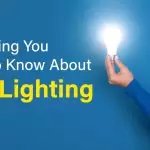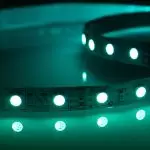LED technology, initially used in indicators and decor, has evolved into industrial-strength lighting. With a lifespan of 30,000 to 50,000 hours and compelling energy savings, LED lighting is now primed for widespread commercial use, supported by robust warranties.
Post your Requirement
The future of lighting, LED surpasses incandescent and fluorescent options, consuming up to 90% less energy. Free of toxic chemicals and recyclable materials, LED not only offers significant cost savings but also stands as a planet-friendly, “green” lighting solution, defining the pinnacle of eco-conscious technology. Read our comprehensive blog on LED Lighting trends to know more about its benefits and contemporary relevance.
What Is LED Light?
LEDs (light-emitting diodes) are solid-state lighting devices. Comprising a semiconductor diode with P-type and N-type materials forming a PN junction, they emit light when an electric current passes through. Electrons and holes combine near the junction, releasing energy in the form of photons, creating visible light. The color emitted depends on the energy level, allowing engineers to manipulate LED colors by using materials with varying band gaps. Blue and purple light result from higher energy emissions, while yellow and red light stem from lower energy emissions, providing versatility in lighting applications.
Key Features Of LED Light
Below we have listed some of the basic features of LED Lights
- Solid State Technology: Utilizes Light Emitting Diodes (LEDs) as a solid-state light source.
- High Energy Efficiency: Outperforms incandescent, fluorescent, and other traditional lights in energy efficiency.
- Low Operating Temperature: Operates at significantly lower temperatures, remaining cool to the touch.
- Environmentally Friendly: Free of hazardous materials and reduces carbon emissions, contributing to a greener environment.
- Durable and Long-Lasting: Boasts durability and extended lifespan, capable of long hours of use.
Types Of LED Lights
Below we have mentioned the most common types of LED Lights:
- LED Bulbs: Energy-efficient, long-lasting, dimmable, versatile color options, environmentally friendly.
- LED Floodlights: High brightness, energy-efficient for outdoors, weatherproof, long-lasting, some with motion sensors
- LED Street Lights: Energy-saving, durable with a long lifespan, directional lighting to reduce pollution, smart controls for remote management.
- LED Spotlights: Focused illumination, energy efficiency, excellent color rendering, dimmable options, compact and stylish designs.
- LED Downlights: Sleek and versatile design, energy-efficient with minimal heat emission, dimmable options, and directional lighting.
- LED Footlights: Subtle illumination for safety, energy-efficient, durable, weatherproof for outdoor use, some with automatic sensors.
- LED Ceiling Lights: Energy-efficient ambient lighting, even illumination, versatile designs, and dimmable options for different occasions.
- LED Night Lights: Low-level comforting illumination, energy-efficient with sensors, various designs for bedrooms and hallways.
- Small LED Lights: Compact size, low power consumption, multicolor options for creative lighting, easy installation in various applications.
- Blue LED Lights: Unique blue color, energy-efficient and durable for both indoor and outdoor decorative applications.
- White LED Lights: Versatile color temperatures, energy-efficient for general illumination, long lifespan, suitable for various spaces.
- LED Shop Lights: High brightness for workspaces, energy-efficient, long-lasting, and durable for workshop environments.
- Square LED Lights: Modern aesthetics with sleek designs, uniform lighting, and versatile applications such as ceiling, panel, or wall-mounted fixtures.
Advantages of LED Lights
Here we have mentioned some of the advantages of using LED Lights:
- Energy Efficiency: LED lights boast significantly lower energy consumption, translating to substantial savings on electricity bills.
- Durability Beyond Comparison: Solid-state design ensures resilience against shocks, vibrations, and temperature changes, guaranteeing a prolonged operational life.
- Versatile Color Options: With a broad spectrum including warm white and cool white, LED lights offer creative lighting possibilities and dynamic color changes for diverse applications.
- Environmental Friendliness: Free from hazardous materials like mercury, LED lights contribute to a cleaner environment by reducing carbon emissions.
- Low UV Emissions: Emitting minimal UV and IR radiation, LED lights are ideal for illuminating UV-sensitive materials without causing damage.
- Smart Capabilities for Convenience: Integration into smart systems allows remote control via apps or voice commands, enhancing user convenience and automation.
- Enhanced Safety: The robustness of LED lights makes them a safer choice, particularly in high-ceiling installations where frequent replacements may be challenging.
Tailored Customization: Adjustable color temperature, brightness, and color provide users with personalized lighting experiences tailored to specific needs and preferences.
Tips To Consider While Buying LED
Below we have mentioned some of the tips to consider while buying LED:
- Assess Brightness Needs: Calculate lumens based on room size and function for optimal illumination.
- Choose Color Temperature:Opt for warm or cool white LEDs based on the desired ambiance.
- Check Fixture Compatibility: Ensure LED lights match existing fixtures or choose fixtures accordingly.
- Explore Smart Lighting: Consider smart LEDs for remote control and automation convenience.
- Measure Installation Space: Confirm LED lights fit properly without overcrowding or leaving dark spots.
- Evaluate Energy Efficiency: Check wattage and energy ratings to align with energy-saving goals.
- Consider Aesthetics: Select LED lights that complement interior design in terms of style and finish.
- Set a Realistic Budget: Establish a budget and choose lights that meet needs within the defined limits.
Best Brands Selling LED Lights
Here is the list of best brands selling LED Lights:
FAQs
Q-1. What is the LED light?
A-1. LED light, or Light Emitting Diode, is a solid-state lighting device that emits light when an electric current passes through.
Q-2. Why LED light is best?
A-2. LED lights are energy-efficient, durable, and eco-friendly, offering longer lifespans and significant cost savings compared to traditional lighting sources.
Q-3. Which is the best LED light for a home?
A-3. The best-LED light for a home depends on preferences. Popular choices include smart LEDs for versatility and energy-efficient warm white bulbs for cozy ambiance.























Post A Comment